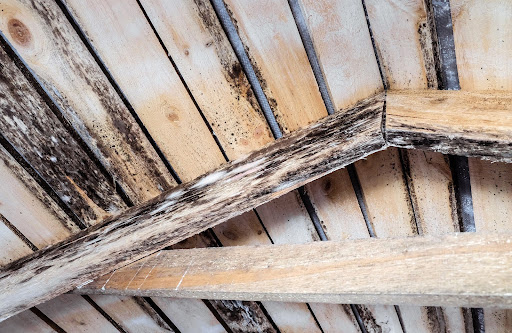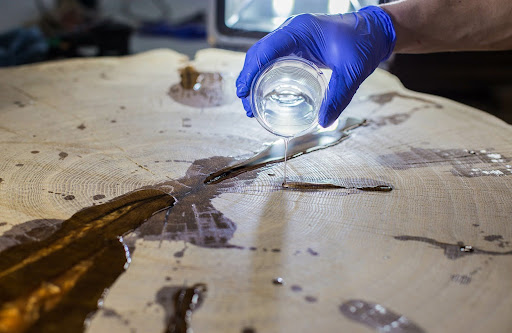
Wood rot treatment is often necessary for a lot of homeowners. Wood rot is a very common problem, especially in homes and buildings with wood framing or exterior wood features such as decks and fencing. When left untreated, wood rot can worsen and compromise structural integrity. It can even spread.
Is Wood Rot Treatment Possible?
When you come across wood rot in your home, you might think it’s going to need a full replacement. However, wood rot treatment is possible in many cases. If you catch it early enough, you can repair wood rot and restore your woodwork back to its original appearance.
Causes of Wood Rot at Home

What exactly causes wood rot? More often than not, wood rot occurs when the wood is exposed to excess moisture. Moisture is a catalyst for fungi, and the fungi that cause wood rot thrive on this. When this fungi develops on wood, it starts feeding on the wood’s fibers, causing it to decay.
There are two types of wood rot, though: dry rot and wet rot.
- Dry Rot. Wood rot grows when there’s excess moisture in the wood. However, dry rot can stick around long after the source of the moisture has disappeared. Dry rot also tends to spread more aggressively than its wet counterpart.
- Wet Rot. When your woodwork is constantly exposed to moisture, it can develop wet rot. Like dry rot, wet rot can weaken the structure of the wood. Eventually, when left untreated, wet rot will lead to damage. Common causes of wet rot include leaky roofs, poor ventilation, and broken gutters.
How to Identify Wood Rot
If you want to stop wood rot from worsening, it’s ideal to learn how to detect it early on. Here are the most common signs that you’ve got a wood rot problem.
- Discoloration. If you notice that affected areas start turning yellow, brown, or black, then you’ve got a case of wood rot on your hands.
- Softness. Rotten wood usually feels soft or spongy. If you press your fingers to the affected area, you’ll likely leave an indentation.
- Cracks. Wood rot can lead to cracks and crumbles in the wood. A surefire sign that you have a wood rot issue is when the wood falls apart in your hands.
- Fungal Growth. A clear indication of rot is when mushrooms or fungi start to grow.
- Musty Odor. If you begin to smell a damp or earthy scent on your wood, it’s a good sign that you have wood rot. This is more common in confined spaces such as basements and attics.
- Paint Bubbling. You can spot wood rot on painted wood when the paint starts to bubble or peel away.
How to Stop Wood Rot
Can you stop wood rot once it starts? The short answer is yes. Even after rotting begins, you can stop wood rot from spreading to other parts if you act quickly.
The best way to do this is to eliminate the source of the moisture. Since moisture causes wood rot, cutting it off at the root will help get you on the right track. Leaky pipes, roof leaks, drainage issues, and cracks in the wood are good places to start, as they are the most common. You should also make sure confined spaces get proper ventilation to keep moisture levels low.
Next, you’ll want to address the affected wood. To stop it from spreading, make sure to dry out the moisture as much as you can. This is where fans and dehumidifiers come in handy. They can help speed up the drying process. After drying the wood, you can then proceed to wood rot repair.
How to Repair Wood Rot
In many cases, wood rot can be repaired using treatments and products designed to strengthen and restore the damaged wood. Here are four common methods for repairing wood rot.
1. Wood Rot Preservative
You can repair rotted wood and prevent further decay using wood rot preservations. These are chemical solutions that contain fungicides, which target the fungi that cause the rot. Make sure to wait until the wood is dry before applying the preservative to the affected area. Allow it to soak into the fibers for the best results.
2. Boric Acid
If you want to repair dry rot, boric acid is a good solution. Boric acid is a natural fungicide, so it can treat wood rot effectively. You can mix it with water and then spray the solution directly onto the affected area. Let it sit for the wood to absorb the boric acid, which will prevent further growth. It’s best used in the early stages of dry rot.
3. Wet Rot Wood Hardener
Wet rot wood hardener is a liquid solution that penetrates and reinforces damaged wood. When you apply it to rotted wood, the hardener bonds with the fibers and solidifies the affected area. If you’ve got soft or spongy wood already, a hardener is the best way to go. Don’t forget to sand and paint the area after the hardener dries. This way, you can restore it to match the rest of the wood.
4. Epoxy

Epoxy is a good wood treatment for dry rot. You can use to repair more extensive damage caused by wood rot.
Epoxy has two parts: a resin and a hardener. You combine these two together to form a durable filler that you can apply to areas with deteriorated wood. You can fill cracks, gaps, and holes.
Due to its nature, epoxy hardens and forms a strong bond that reinforces the structural integrity of the wood. Just like with wet rot wood hardeners, epoxy should be sanded, painted, or stained give the wood a more uniform appearance.
When to Replace Wood
If wood decay treatment isn’t enough, you’ll need to replace the wood altogether. Repairing the wood rot is usually possible, but there are cases wherein you need a replacement. For instance, if there is extensive damage or weakened structural integrity, replacement is a much safer and cheaper solution.
Here are a few signs that wood replacement may be necessary:
- The wood is severely weakened and no longer supports weight.
- Rot has spread across a large area, making repairs impractical.
- The wood has disintegrated, leaving gaps or holes that cannot be filled.
- In cases where structural wood, such as beams or framing, is affected, replacement is often the best solution to ensure the safety and stability of the home.
How to Prevent Wood Rot
Although wood rot treatment is possible, prevention is always preferred. You can protect your home and prevent wood rot with a few simple maintenance tricks.
- Make sure to keep wood surfaces dry, especially exterior components that are exposed to the elements.
- Conduct regular inspections for leaks and drainage issues that could cause excess moisture.
- Consider using pressure-treated wood for outdoor structures. Such wood is less likely to absorb moisture and is, therefore, more resistant to decay.
- Ensure proper ventilation and airflow in confined spaces to limit the buildup of moisture.
- Apply sealants or paint on wood surfaces, particularly outdoor structures. This creates a protective barrier against moisture.
- Perform regular inspections on wood structures to identify early signs of rot.
The Bottom Line
Wood rot treatment is integral to the structural integrity and appearance of your wood elements. Learning the early signs of wood rot will help you stop the rot from spreading and repair the affected wood as soon as possible. However, in more severe cases, you might need a total replacement.
Queen City Painting Company offers wood rot treatment services to residential and commercial properties in the Charlotte area. Call or text Ron directly at 704-996-9266 for a quote. You can also contact us here!
